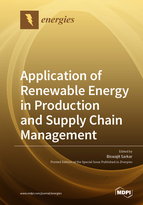Application of Renewable Energy in Production and Supply Chain Management
A special issue of Energies (ISSN 1996-1073).
Deadline for manuscript submissions: closed (31 July 2019) | Viewed by 24677
Special Issue Editor
Interests: supply chain management; optimization; artificial intelligence; smart production; mathematical modelling; inventory management; smart logistics; biomathematics; circular economy; sustainability; renewable energy
Special Issues, Collections and Topics in MDPI journals
Special Issue Information
Dear Colleagues,
Today, the application of renewable energy is increasing in supply chain management (SCM). Different forms of energy are consumed during the manufacturing and retailing of products, which includes electricity generation, air and water heating/cooling, transportation, and some other energy services. This energy consumption increases when the system is based on a smart supply chain. The establishment of the energy transition to renewable energy sources has become one of the important global development in recent times, resolving the serious problem of sustainable energy supply in SCM.
Renewable energy is collected from some resources that are naturally replenished on a human timescale such as solar, wind, rain, tides, waves, and geothermal heat. In comparison to other energy sources, renewable energy resources exist over wide geographical areas. The development of inexpensive, vast, and clean solar energy technologies have massive long-term benefits. A slow flowing stream of water or moderate sea swell can yield considerable amounts of energy. Airflows can be used to run wind turbines. These renewable energy resources increase system’s energy security, enhance sustainability, reduce pollution, decrease the cost of mitigating climate change, and keep fossil fuel at lower prices. These advantages have a global impact on environment. Hence, shifting energy consumption from fossil sources to renewables is a main objective of SCM and smart supply chain management (SSCM) to make it an energy-efficient supply chain management (EESCM). Thus, the aim of this proposal is to save energy in several ways under the framework of SCM.
Prof. Dr. Biswajit Sarkar
Guest Editor
Manuscript Submission Information
Manuscripts should be submitted online at www.mdpi.com by registering and logging in to this website. Once you are registered, click here to go to the submission form. Manuscripts can be submitted until the deadline. All submissions that pass pre-check are peer-reviewed. Accepted papers will be published continuously in the journal (as soon as accepted) and will be listed together on the special issue website. Research articles, review articles as well as short communications are invited. For planned papers, a title and short abstract (about 100 words) can be sent to the Editorial Office for announcement on this website.
Submitted manuscripts should not have been published previously, nor be under consideration for publication elsewhere (except conference proceedings papers). All manuscripts are thoroughly refereed through a single-blind peer-review process. A guide for authors and other relevant information for submission of manuscripts is available on the Instructions for Authors page. Energies is an international peer-reviewed open access semimonthly journal published by MDPI.
Please visit the Instructions for Authors page before submitting a manuscript. The Article Processing Charge (APC) for publication in this open access journal is 2600 CHF (Swiss Francs). Submitted papers should be well formatted and use good English. Authors may use MDPI's English editing service prior to publication or during author revisions.
Keywords
- Green supply chain management with renewable energy
- Application of energy in production system
- Renewable energy in inventory management
- Energy-efficient supply chain management
- Energy efficiency and energy consumption
- Sustainable energy and energy saving






